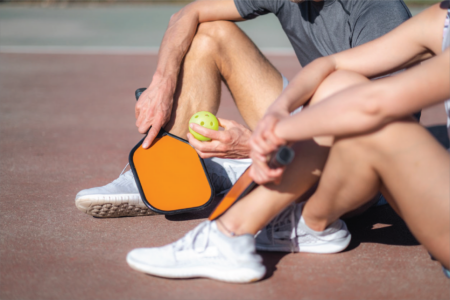
America’s fastest growing sport is pickleball. And as the popularity of this paddle sport has grown, so have pickleball injuries.
Set on a court 44 feet long by 20 feet wide, the game demands quick movements and sudden changes in direction as players hit the wiffle-like ball over a net with a paddle. While pickleball is easy to learn, it can prove quite challenging.
The game’s abrupt changes in speed and direction can precipitate acute injuries such as broken ankles and ruptured Achilles tendons. Generally played on a hard surface, pickleball can also lead to overuse injuries like plantar fasciitis, Achilles tendonitis and stress fractures.
Fortunately, there are ways to prevent pickleball injuries.
Selecting the proper footwear is essential. Make sure your shoes are comfortable, secure and offer a solid grip to help prevent slips and falls. Pickleball court shoes are designed for the quick side-to-side motions common in the sport. Supportive tennis shoes offer another good choice. Avoid wearing running shoes, which are designed for forward, rather than lateral motion.
Before hitting the court, a five to 10-minute warmup can reduce the chance of injury. A short jog, or lunges, arm circles, knee lifts and jumping jacks can improve blood flow to muscles and help loosen your joints, priming them for play.
A slow walk or light stretching after the game can help you cool down, allowing your heart rate and blood pressure to return to their pre-exercise state. A cool down can also help reduce muscle cramps.
If you are new to the sport, ease into it. Listen to your body and take a break if you become tired. You are more likely to injure yourself when fatigued.
Doing other forms of exercise away from the court, such as running, swimming or riding a stationary bike, will build up your cardiovascular fitness and strengthen your pickleball play. Strength training can improve your balance and reflexes on the court.
If you do suffer from pain or a minor injury caused by pickleball, follow the PRICE protocol: protect the injured area, rest, ice the injury, compress it with an elastic bandage, and elevate it. If pain persists or you suffer an acute injury such as a broken ankle, seek medical attention.
For more information on foot and ankle injuries or to schedule an exam, contact Wentz Foot & Ankle Specialists at 719-539-6600.
Dr. Ralph Wentz is a board-certified foot and ankle surgeon in Salida and a fellow of the American College of Foot and Ankle Surgeons.
